
Dramatic coastlines, half-timbered towns, thatched roofs, and rolling hills of green – a visit to Normandy offers all of these and much more. Parisians call Normandy their “21st arrondissement” because it is their escape with the nearest beaches, but it’s a great escape for everyone else too.
History lovers will especially find plenty to see and do. From the Vikings that invaded in the 9th century to WWII when Normandy’s beaches hosted a battle that changed the course of history. Today, though there are still reminders of these events, what prevails is a quiet peacefulness.
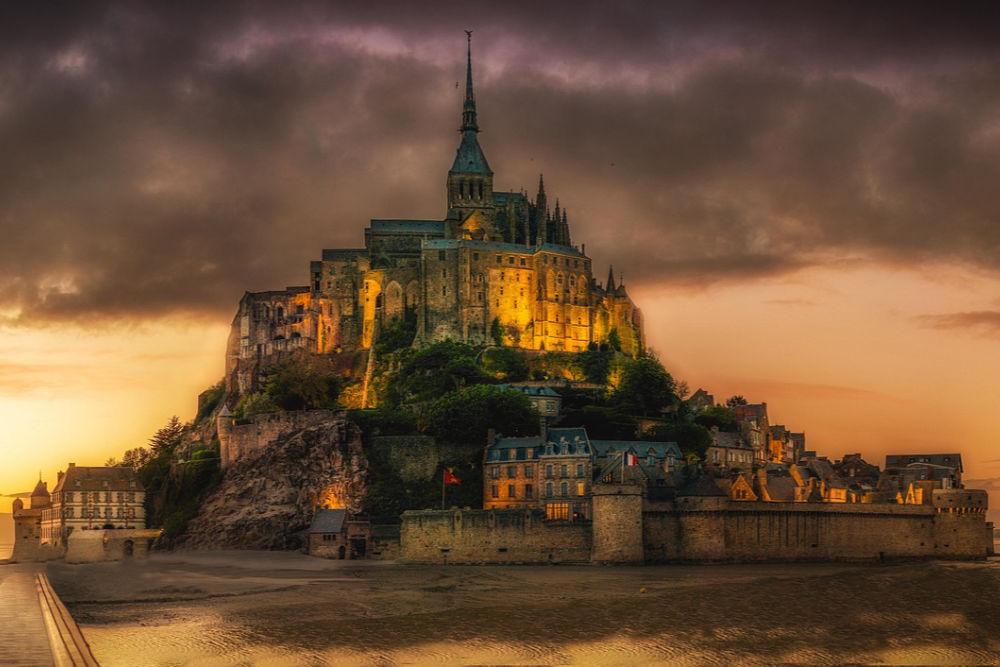
A visit to Normandy offers the chance to explore rustic charming villages, discover its fascinating history, and then indulge in delicious seafood, cider, and cheese.
Whether you’re visiting for a weekend, a week … or longer, here are eight great places to visit in Normandy to experience the best the region has to offer.
This post may contain affiliate links. Please read our full disclosure policy here.
TABLE OF CONTENTS
8 GREAT PLACES TO VISIT IN NORMANDY FRANCE
Honfleur escaped the bombs of WWII and today is a romantic picturesque port enclosed on three sides lined with outdoor cafés – a pretty start to any trip in the Normandy region of France.
The town is a working port with a long maritime history where sailors have enjoyed its location where the Seine River meets the English Channel. Also of historic importance is this little harbour is where Samuel de Champlain sailed from in 1608 to North America when he discovered St. Lawrence and founded Quebec City.
Today, as the pretty town has been since the 19th century, it is a magnet for artists to paint colourful scenes. Impressionist Eugène Boudin was born in Honfleur who then met up with Claude Monet (from nearby Le Havre) and they propped up their easels in the open air along the Vieux Bassin and created some wonderful works of art.
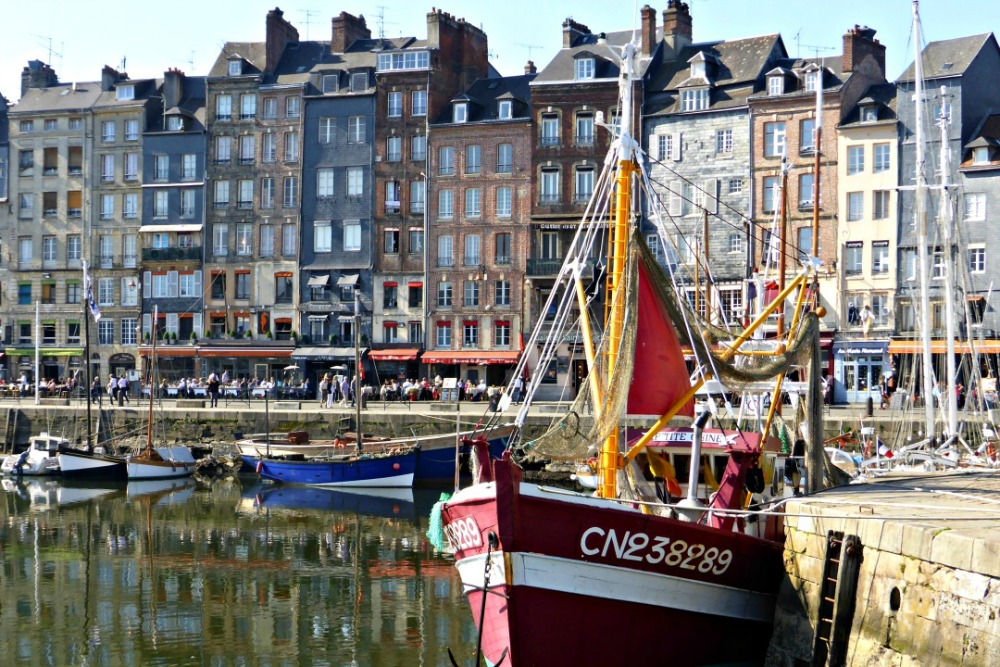
MUST DO IN HONFLEUR:
- Le Vieux Bassin: The old harbour, lined with shops and houses and full of pretty boats, dates back to the 17th century. Early risers can watch what remains of Honfleur’s fishing fleet prepare for the day and will be treated to good light for photos. Plan to stay for the evening too, as dining on fresh seafood outside at one of the restaurants along the quay as the lights come on to reflect in the water is not to be missed.
- Église Ste-Catherine: Built to replace a church destroyed in the Hundred Year’s War, the largest wooden church in France is half-timbered inside and out. It features twin naves, tall oak pillars, and a ceiling that looks like the hull of a ship – a legacy to the community of sailors and fishermen that were master boatbuilders instead of cathedral architects. Also unique to this church is the bell tower, not built atop the church, but across the square instead!
- Greniers à Sel: Built in the late 16th century, three large salt stores were constructed in the main street to meet the needs of the increased demand for salt as a preservative for the growing cod catches. Unfortunately, one of the buildings was burned in 1892, but today the remaining buildings can be visited (for exhibitions and concerts) to see the walls built of stone from the old ramparts and the oak roofs – still in great condition.
Reviews of Le Vieux Bassin | Reviews of Église Ste-Catherine | Reviews of Greniers à Sel
Rouen is a 2,000-year-old city that mixes Gothic architecture, half-timbered houses, impressive churches, and modern hustle and bustle. Its focal point is the Place du Vieux Marché (Old Market) where Joan of Arc was burned at the stake in 1431. The market includes many pretty buildings, along with a unique church built to honour Joan of Arc.
During its long history, it was the regional capital during Roman times, and then France’s second-largest city (to Paris) during Medieval times. Its historic wealth was based on the wool industry and trade because it was for centuries the last bridge across the Seine River before the Atlantic.
In more recent history Allied bombers destroyed about half the city, mostly in the industrial suburbs so the historic core survived which leaves it is a delight for strolling and exploring.
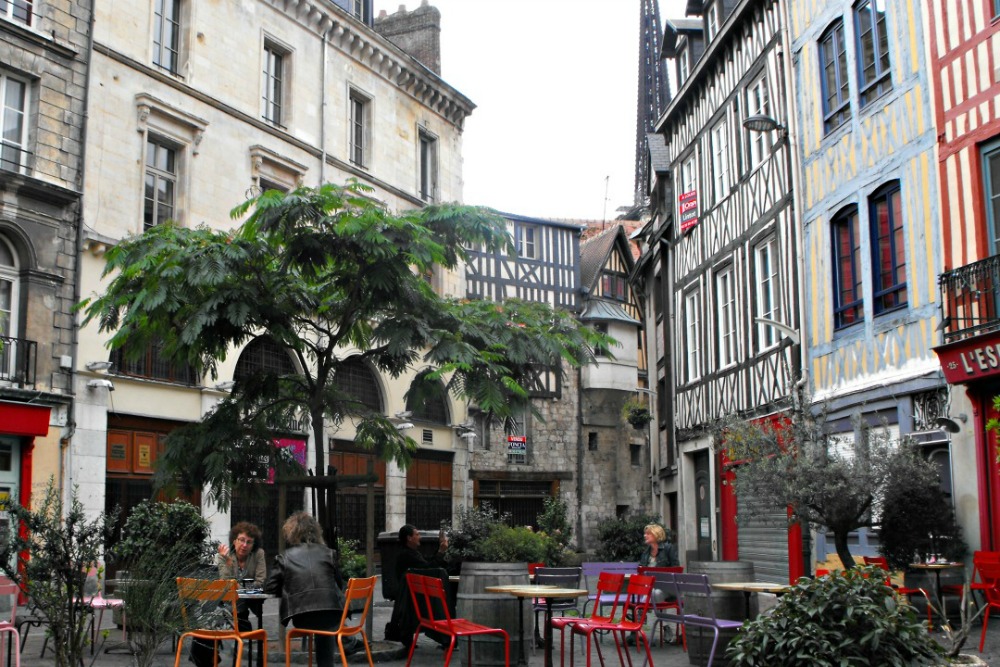
MUST DO IN ROUEN:
- Cathédrale Notre-Dame de Rouen: Located in the historic heart of the city, this majestic cathedral took 400 years to construct and has captured the attention of artists ever since – especially Monet who painted the west façade 30 times in two years to capture it in different weather conditions and lighting.
- Le Gros-Horloge: Comprised of a Gothic belfry, a Renaissance archway, and ornate clock face, the Great Clock houses the city bells and allows visitors to climb up inside for a great view of the city.
- Rick Steves’ Self-Guided Walk: Starting in front of the Cathédrale Notre-Dame, Rick Steves guides you on a one-hour walk that shows you the essential historical Rouen sights and gives you a taste of the city’s history.
Reviews of Cathédrale Notre-Dame de Rouen | Reviews of Le Gros-Horloge
Known the world over for its famous tapestry, Bayeux itself is less well known, yet full of charm and deserving of a visit if you are in the Normandy region.
This small cathedral town is only six miles from the D-Day beaches and was the first city liberated after the landings. Incredibly the town was spared the bombs of WWII when a local chaplain made sure that those in London knew it was not a German headquarters and therefore of no strategic importance so a scheduled bombing was called off.
Bayeux is now a great base for visiting the D-Day sites of Normandy, but be sure to allow for time to explore its treasures too.
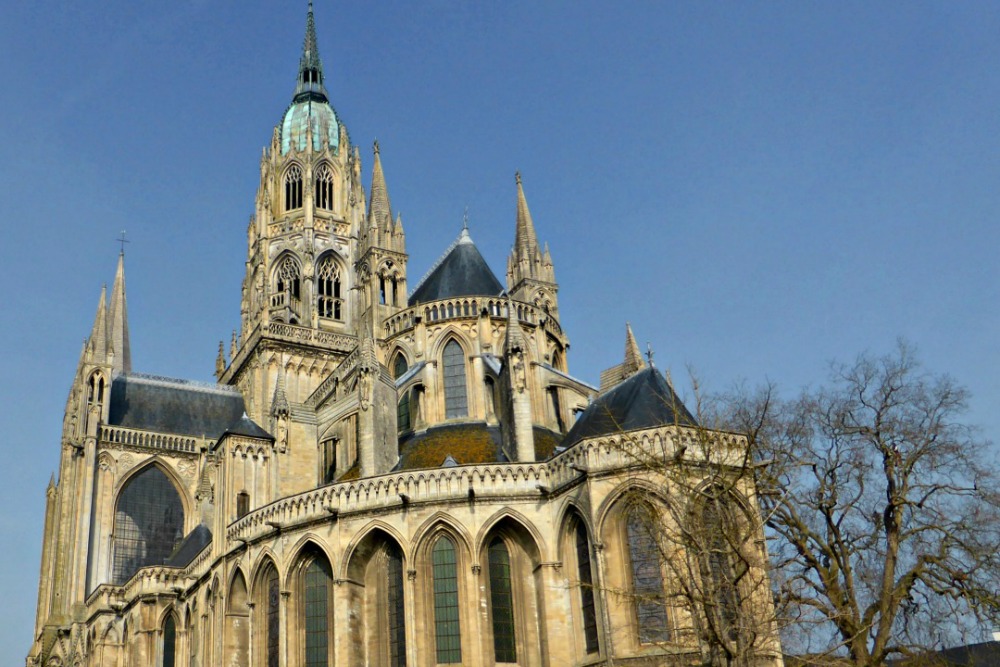
MUST DO IN BAYEUX:
- Cathedral of Notre-Dame: Dates back to the days of William the Conqueror (he was there when it was consecrated in 1077) and the Battle of Hastings and it is stunning! It’s been much altered over the centuries and is now a combination of a Romanesque style in the 11th-century crypt and Gothic style in the 13th-century nave. It was also the home of the Bayeux Tapestry from the 11th to 18th centuries.
- Bayeux Tapestry: Now at home in the Musée de la Tapisserie de Bayeux, this unique historical document isn’t actually a tapestry at all but an embroidered 70m long strip of linen. It is an outstanding work of art that tells the story of the Norman conquest of England in 1066 in a series of about fifty scenes. The fact that it was created over nine centuries ago just makes it all the more impressive.
- British War Cemetery and Memorial: The largest Commonwealth war cemetery in France, it was completed in 1952 and now contains the graves of 4,144 fallen soldiers from the Commonwealth. There are also another 500 war graves of other nationalities, with the majority of these being German. The Bayeux Memorial stands just across the road from the cemetery and commemorates more than 1,800 men from the Commonwealth forces who died early in the fighting after the D-Day landings and have no known grave.
Reviews of Cathedral of Notre Dame | Reviews of Bayeux Tapestry | Reviews of British War Cemetery and Memorial
It was on the beaches of Arromanches-les-Bains that the Allies established an artificial temporary harbour that allowed them to unload heavy equipment before the deep ports of Le Havre and Cherbourg could be captured.
Arromanches is in the centre of the Gold Beach (British) landing zone but it was spared as much fighting as possible on D-Day so the harbour could be installed as quickly as possible. During 100 days of operation, this temporary port allowed 2.5 million men, 500,000 vehicles, and 4 million tons of material to come ashore. To say this was an amazing engineering feat is an understatement.
Today visitors can see the remnants of the pontoons that once held up the floating roadway but you must plan to be here during low tide to do this otherwise they are covered with water.
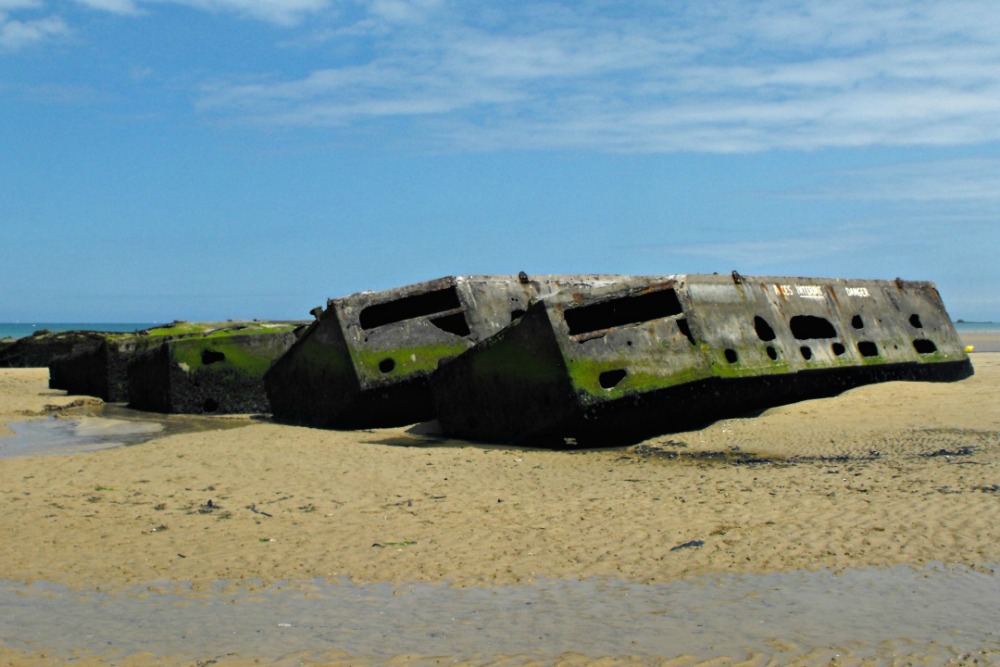
MUST DO IN ARROMANCHES-LES-BAINS:
- Musée du Débarquement: This museum pays homage to the famous artificial port with an amazing model that shows and explains how it all worked. If, like me, you just can’t visualize how the remnants on the beach fit together and how it worked then this is a must-see.
- Gold Beach: The beach where the British 50th Division set up the Mulberry Harbour – a testament to the ingenuity of Winston Churchill. He realised if the troops wanted to land, they would need to bring their harbours with them.
- Arromanches 360° Theatre: Set up on the bluff overlooking the beach, this circular theatre shows a moving film called Normandy’s 100 Days. This features archival footage collected from around the world to tell the whole story of the 100 days of the Battle of Normandy. It is a tribute to the men of all nations who fell and to the 20,000 civilians killed during the liberation of Western Europe.
Reviews of Musée du Débarquement | Reviews of Gold Beach | Reviews of Arromanches 360° Theatre
Once a fishing village and then a popular seaside resort in the 19th-century, this is quite possibly Normandy’s most alluring coastal town. Located on the Alabaster Coast, nature has carved out wonderful shapes in the white cliffs and they definitely steal the show – especially at sunset!
There is more to Étretat though than the cliff formations. The small resort town is full of charm and has a wooden covered market made for exploring and shopping. The pebble beach would be the perfect spot for a little picnic with some finds from the market and the cliff tops are just waiting for walkers or golfers to enjoy the views.
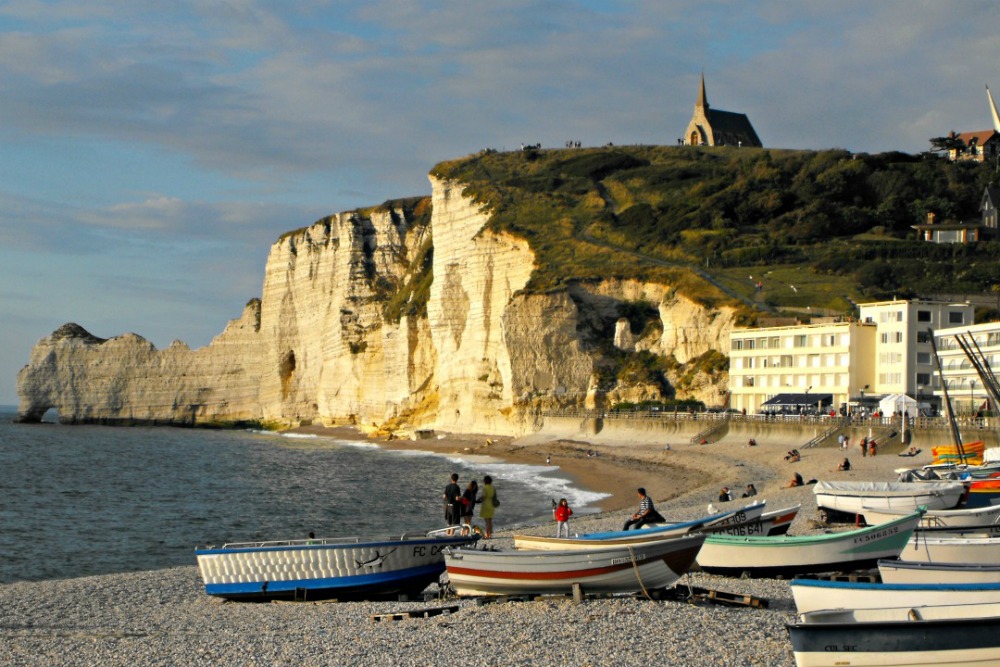
MUST DO IN ÉTRETAT:
- Esplanade and Beach: Curving along the pebble beach is a restaurant-lined esplanade just made for strolling, especially at dusk to see the cliffs spectacularly lit up. Wooden boats line the beach and provide colourful photo ops.
- Falaise d’Amont and Falaise d’Aval: Each cliff has been hollowed out by the sea to form dramatic arches. Falaise d’Amont’s natural archway has been likened to an elephant dipping its trunk into the water and when the tide is out you can walk along the beach almost to the foot of the arch. From the clifftop of Falaise d’Aval, you can admire the aiguille (needle) of rock coming up out of the water.
- Notre-Dame de la Garde: Perched on the edge of the Falaise d’Amont, this little mariner’s chapel originally dates back to 1856. It was destroyed in WWII but rebuilt in 1950 and still offers sweeping views out to sea.
Reviews of Esplanade and Beach | Reviews of Falaise d’Amont and Falaise d’Aval | Reviews of Notre-Dame de la Garde
Less than an hour from Paris, Giverny is famous for Monet’s house and gardens including the water-lily pond featured in his beautiful works of art. Here you can pay homage to this great painter right in his own home that he lived in from 1883 until his death in 1926.
The best months to visit are May and June when the rhododendrons flower around the lily pond and the wisteria hang over the Japanese bridge, but really it’s beautiful any time of the year if you can’t make it in the spring.
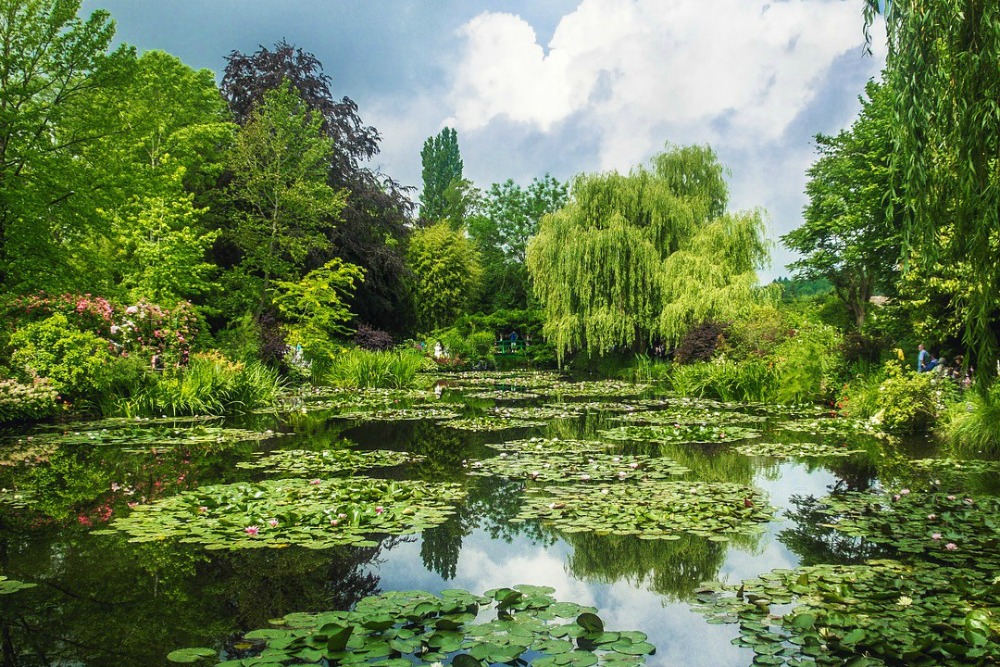
MUST DO IN GIVERNY:
- Musée des Impressionnismes: Learn about the history of Impressionism and Post-Impressionism in this wonderful museum. You can also enjoy the gardens with flowerbeds in monochromatic colour schemes and the hills of Giverny filled with poppies, daisies, and wildflowers.
- Monet’s Water Garden with Japanese Bridge: A place of calm contemplation featuring the waterlilies and wisteria-draped Japanese bridge that Monet painted and made so famous.
- Monet’s Home: Step inside to see how the artist himself lived with a tour that includes his sitting-room studio, dining room, and his bedroom where he slept for 43 years. The home still includes most of the original furnishings.
Reviews of Musée des Impressionnismes | Reviews of Monet’s Water Garden
Founded in 1517 to replace the silted up ports of Honfleur, Harfleur, and Caudebec, Le Havre is now the second largest port in France.
Most of the city was destroyed by Allied bombings in WWII so there isn’t much of the historic architecture left, but that is one thing that makes it unique. It was rebuilt with the designs of Auguste Perret, which have given it a very uniform look and feel. It is considered an outstanding post-war example of urban planning and architecture and is now inscribed on the list of UNESCO World Heritage Sites.
Although long dismissed as a boring stopover, Le Havre has an unexpected side that makes it a great stop for a day or two on any Normandy road trip itinerary.
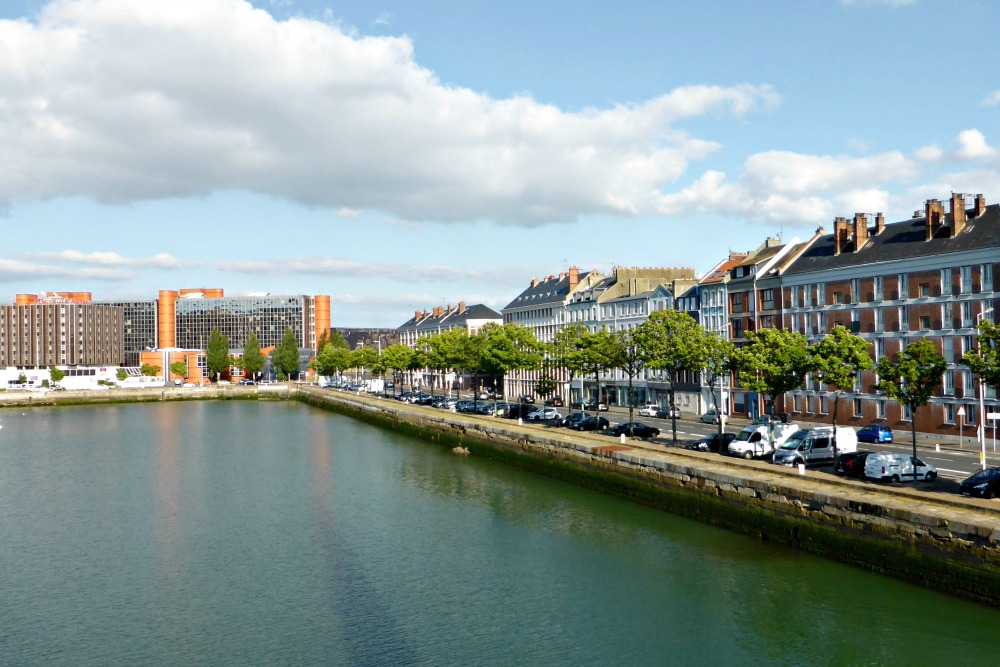
MUST DO IN LE HAVRE:
- Musée Malraux: An innovative building, made from glass and metal that offers views of the port through a concrete sculpture known as “The Eye” that is filled with light. It spans five centuries of art history and is home to France’s second-largest collection of Impressionist paintings.
- Église St. Joseph: The spire of St. Joseph’s church rising 107 m into the sky in Le Havre is hard to miss, which allows sailors to use it as a lighthouse to navigate into the harbour safely. Designed by Auguste Perret after the war and built on the site of earlier churches that had been destroyed, this is now a landmark in the city. Although it looks a bit austere on the outside, inside it is a treat when the light shines through the thousands of stained glass windows.
- Bassin du Commerce: If you enjoy the sea, there are many places to walk close to the water in and around Le Havre. In addition to a beach promenade, there is also the Bassin de Commerce that features a unique pedestrian bridge, a cultural centre called Le Volcan, and the city’s beautiful war memorial.
Reviews of Musée Malraux | Reviews of Église St. Joseph | Reviews of Le Volcan
One of the most spectacular sights in Normandy, this craggy rock dominated by its monumental abbey appears to erupt from either the sea or sand, depending on dramatic tides.
Mont St. Michel became a place of pilgrimage when St. Aubert built an oratory here over 1,00 years ago; it continues to welcome visitors to the tune of about three million per year and has about 50 true inhabitants.
Until recently the island was attached to the mainland by a causeway with a road, but is now, once more an island that is connected by a bridge under which the water ebbs and flows with the tides.
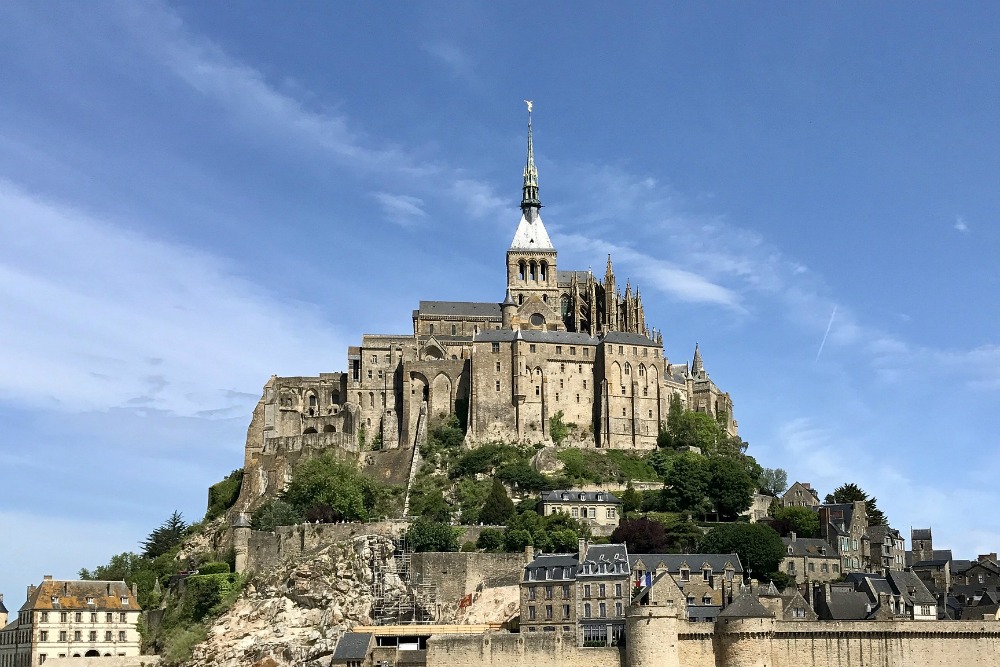
MUST DO IN MONT ST. MICHEL:
- The Abbey: The striking Gothic abbey which is visible from all around the bay appears to have been sculpted from the granite to match the contours of the hill. Visitors can explore the cloisters, knights’ hall, refectory, and guest rooms. I recommend Rick Steves’ self-guided walking tour which I have personally followed to get more out of your visit.
- Grande Rue: Through the fortified Porte du Roy, the Grande Rue winds steeply uphill with its portcullis still visible. This narrow cobbled street was the original route used by pilgrims in the 12th-century and is still the route visitors used today, though it is likely a lot more crowded today! It is lined with souvenir shops and restaurants but there are hidden gems to be found if you look up and at the details of the buildings around you.
- Ramparts: Punctuated by imposing towers, the ramparts were built to repel the English during the Hundred Years’ War. The abbot’s soldiers also lived in the Tour de l’Arcade but today the ramparts are likely most visited for their lovely views of the bay.
Looking for more information to plan your visit to Normandy? You may find these articles helpful.
RESOURCES | PLAN YOUR TRIP TO FRANCE
To book flights, rental cars, accommodations, and activities for your trip, please check out our recommended travel providers, favourite apps and websites.
- For all things France, you can’t go wrong with Rick Steves! Check out his France travel guide, full episodes of his TV show, or download his app for excellent audio tours.
Some of the links in the post above are affiliate links. This means if you click on the link and purchase the item, we will receive an affiliate commission but this does not affect the price to you. Please read our full disclosure policy here.
